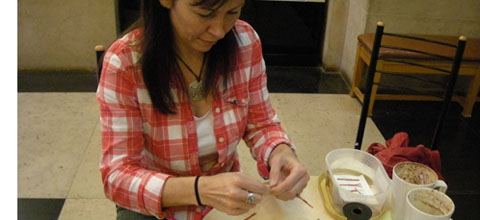Julia Thomas has changed career from scientific to artistic, and now the two go hand in hand.
For some people science and art may go together like chalk and cheese, but for Julia Thomas, 42, they are a perfect marriage. Since she decided that her career in science alone was not enough she has been using it to inform her artwork and her interactions with the public, to interesting effect.
At school in Yorkshire, Julia had to choose between her two passions. “They’d said if you’re good at science you should do science, even if you like art, because there’ll be more opportunities. So I went down the science route, and said I would always do art as a hobby. But I was actually quite gutted.”
As for where she gets her passions from, it seems to be a case of it being in the genes; she describes her father as very logical, very scientific, and her mother as the creative one.
Science took Julia to Swansea University to study genetics and statistics. “I was very happy then, because I’d always wanted to be fairly interdisciplinary, and even though there wasn’t art in there I think the combination of having genetics and statistics grabbed me. I’ve always been in awe of how complex but beautiful genetics is.”
A scientific job then took her to Oxfordshire, and then Cardiff. After almost ten years she returned to art as a hobby, but found herself unable to devote enough time to both. “Once I started I realised how much I’d missed it, because once I’d had kids I just didn’t have time anymore. I tend to throw myself into things and it was either one thing or the other so I gave the job up, much to everyone’s surprise.” There was no going back.
The change certainly seems to have been the right move. “I’m in my element now. When people ask me about how I’ve got where I am I always think I’m like a squash ball that’s bounced around the court a lot and tried different things, and now I feel like I’ve finally got that really nice shot that lands in the back corner.”
Julia’s work is driven by the desire to stimulate conversation between art, science and the public. Talking about it, her enthusiasm increases and she speaks with a focus intended to ensure her opinions are understood. “It’s not about the aesthetics of it, and some of the work isn’t necessarily aesthetically pleasing either. Someone sent me an email about my work and said that it was ‘stunning, interesting, and challenging.’ I can’t ask for more than that, can I?”
Speaking of reactions to her work, she’s also had less cheerful comments. In response to one work- a recording of a disjointed, unfocussed story, ending with a child’s voice whispering “quiet mummy”- she was told that it was about marital abuse, infanticide and suicide, and that it had kept somebody up all night through fear. In fact no details at all were given; the piece was created while pondering how what we put out into the world about ourselves can often be just a tiny picture. “It was never intended to be nice,” she laughs, “it was intended to be challenging and to make you think.”
Julia has ambitious plans concerning art, science and their combined ability to help people express things. She runs “creative genetics workshops” with children aged three to sixteen who have chronic granulomatous disorder, which she would like to see employed with other groups who have genetic conditions. She describes working with one boy who was very quiet and lacked the confidence to express himself, but who by the end was thoroughly excited by it. “To see someone go from being really introverted and not wanting to be involved- you can see how proud they are of what they’ve done, it’s fantastic.”
Such highs must come with lows as well. She has worked with a lot of ill children, and one particularly enthusiastic one sticks in her mind as the “I can do that kid”. In a sombre change of mood she describes seeing him go from being lively to tired and unwell, and then passing away a few weeks later. She struggles to find words to describe her feelings over this, before saying, “The other kids see all that and they realise that their condition is really serious.”
Looking to the future, Julia plans to continue her current work, made up of a thousand tiny red wire figures representing patients lost in ‘big science’. She also has plans to draw together scientists and artists with corresponding passions; communication is the core of her work. “It’s not about putting a piece of work on the wall, walking away and going ‘look at me, I’m an artist.’ It was always going to be about talking to people.”

